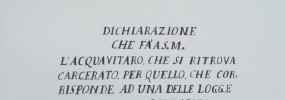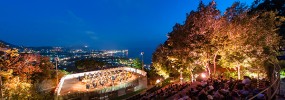
The screen on the Castle
In the most attractive place that, as Wladimiro Frenkel wrote in 1934, “sums up the prehistoric and historic life of the island of Ischia and preserves and passes on the lasting memory and that for five centuries - from the sixteenth to the nineteenth - has been the scene of the glories of the nobility and oppression of the schemes, the Aragonese Castle, will be held from June 29 to July 6, 2013, the eleventh edition of the Ischia Film Festival, the only international competition dedicated to the film locations.

After centuries of oblivion, the Masonic Code of Ischia tells its story
In these days it is exposed at the entrance to the conference hall. Well visible to anyone who enters, on the side opposite the plaster bust of Monsignor Onofrio Buonocore, founder of the Antoniana Library from whose windows you can admire the Aragonese Castle and penetrates the salty air of the nearby sea. The paper strongly yellowed by time, with large signs of humidity, indicates its most evident value in the past. But it is not for this reason that the book with the blue cover has won so much visibility, until it became the protagonist of another book, just published by Lucia Annicelli, director of the Library: “Il codice massonico di Ischia”. The fruit of ten years working around those yellowed pages, swallowed for decades by the darkness in one of the Antoniana’s walnut cabinets.

GIARDINI LA MORTELLA COMING SOON
GIARDINI LA MORTELLA COMING SOON
After the long stop due to the COVID-19 emergency, the La Mortella Gardens announce that they will reopen for visits on Tuesday 16 of June 2020. During the lockdown months the Gardens have never stopped, and while nature continued its cycle with success of seasons and blooms, the staff continued to work to prepare for the reopening, so that La Mortella could welcome visitors, once phase 2 started, in total safety and in compliance with current regulations.

Of Water and Time
by Raffaele Mirelli
In dialogue with Giuseppe Di Meglio and Luciano Iacono at the Sources of Nitrodi NymphsFrom the Absolute to the Principle, as Hegel of Talete (the philosopher par excellence) said, from Aristotle defined the first “wise” of a long and troubled history of thoughts and thoughts.
The human being is composed of water; all organisms contain it in a small basin called body. It is precisely on our body that flows, miraculous, divine, to whom we are devoted as a symbol of salvation.

Aenaria, the mythical Roman city returned from the sea
For nineteen centuries, the thick prairie of Posidonia had guarded and protected it. The ancient Aenaria was now only a legend. As the landing of Enea, in that bay crouched between the great island and the Aragonese Castle. Where no one had ever found traces of the mythical Roman city that had transmitted its name to the entire island. Until the summer of 1973, when two friends, during a dive between the Scogli of Sant’Anna, found a strange old “thing”. Galena, experts had ruled. Was a first sign of Aenaria’s existence? The positive response came from the research carried out in August, which brought to light findings capable of witnessing a submerged city, precipitately abandoned by the inhabitants between 130 and 150 AD, before being inexorably swallowed by the sea.

Nitrodi: millennial flow of health and wellbeing
“Copiosa sempre scaturisce a piedi di un ammasso di pezzi di lava sorretto da un muro ove sono appilcati tre piccoli doccioni, per i quali l’acqua fluisce”
G.D’Ascia 1864
The story of the source of Nitrodi is really unique and extraordinary. It is well known that in the first century B.C. the Source of Nitrodi enjoyed a certain fame throughout the Roman Empire. The numerous reliefs found in the spring of 1757 at the source and now kept at MANN show that the users of the time came from various parts of the Empire and belonged to the highest social classes. The history of the Source in Greek times, meanwhile, is still little known and unstudied. Recent modernization works on the ground floor of the structure have highlighted and highlighted the ancient “doccioni”, which are still functioning today, which have made it possible to ascertain how some large stone blocks useful to support such gutters are most likely made in Roman times before the Roman era. The source in this historical period was consecrated to God Apollo and Ninfe Nitrodi. They thought in the miraculous waters, apparently still today, through the tutors who played their role effectively. In our time, scholars, curious about the beneficial effects of this fantastic water, replace that one of science, in Apollo and the Nymphs.









